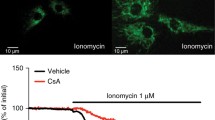Abstract
The loss of mitochondrial cristae integrity and mitochondrial swelling are hallmarks of multiple forms of necrotic cell death. One of the most well-studied and relevant inducers of mitochondrial swelling is matrix calcium (Ca2+). Respiring mitochondria will intake available Ca2+ into their matrix until a threshold is reached which triggers the opening of the mitochondrial permeability transition pore (MPTP). Upon opening of the pore, mitochondrial membrane potential dissipates and the mitochondria begin to swell, rendering them dysfunctional. The total amount of Ca2+ taken up by a mitochondrion prior to the engagement of the MPTP is referred to as mitochondrial Ca2+ retention capacity (CRC). The CRC/swelling assay is a useful tool for observing the dose-dependent event of mitochondrial dysfunction in real-time. In this technique, isolated mitochondria are treated with specific boluses of Ca2+ until they reach CRC and undergo swelling. A fluorometer is utilized to detect an increase in transmitted light passing through the sample as the mitochondria lose cristae density, and simultaneously measures calcium uptake by way of a Ca2+-specific membrane impermeable fluorescent dye. Here we provide a detailed protocol describing the mitochondrial CRC/swelling assay and we discuss how varying amounts of mitochondria and Ca2+ added to the system affect the dose-dependency of the assay. We also report how to validate the assay by using MPTP and calcium uptake inhibitors and troubleshooting common mistakes that occur with this approach.
Access this chapter
Tax calculation will be finalised at checkout
Purchases are for personal use only
Similar content being viewed by others
References
Bernardi P, Lisa FD (2015) The mitochondrial permeability transition pore: molecular nature and role as a target in cardioprotection. J Mol Cell Cardiol 78:100–106
Gunter TE, Buntinas L, Sparagna G et al (2000) Mitochondrial calcium transport: mechanisms and functions. Cell Calcium 28(5–6):285–296
Briston T, Roberts M, Lewis S et al (2017) Mitochondrial permeability transition pore: sensitivity to opening and mechanistic dependence on substrate availability. Sci Rep 7:10492
Karch J, Kwong JQ, Burr AR et al (2013) Bax and Bak function as the outer membrane component of the mitochondrial transition pore. PNAS 111(29):10396–10397
Kroemer G, Reed J (2000) Mitochondrial control of cell death. Nat Med 6:513–519
Patel P, Karch J (2019) Regulation of cell death in the cardiovascular system. Int Rev Cell Mol Biol 353:153–209
Millay DP, Sargent MA, Osinska H et al (2008) Genetic and pharmacologic inhibition of mitochondrial-dependent necrosis attenuates muscular dystrophy. Nat Med 14(4):442–447
Panel M, Ghaleh B, Morin D (2018) Mitochondria and aging: a role for the mitochondrial transition pore? Aging Cell 17(4):e12793
Readnower RD, Hubbard WB, Kalimon OJ et al (2021) Genetic approach to elucidate the role of Cyclophilin D in traumatic brain injury pathology. Cell 10(2):199
Burattini S, Falcieri E (2013) Analysis of cell death by electron microscopy. Methods Mol Biol 1004:77–89
Crowley LC, Christensen ME, Waterhouse NJ (2016) Measuring mitochondrial transmembrane potential by TMRE staining. Cold Spring Harb Protoc 2016:pdb.prot087361
Martin DB, David GN (2011) Assessing mitochondrial dysfunction in cells. Biochem J 435(2):297–312
Harisseh R, Abrial M, Chiari P et al (2019) A modified calcium retention capacity assay clarifies the roles of extra-and intracellular calcium pool in mitochondrial permeability transition pore opening. J Biol Chem 294:15282–15292
Rajdev S, Reynolds IJ (1993) Calcium green-5N, a novel fluorescent probe for monitoring high intracellular free Ca2+ concentrations associated with glutamate excitotoxicity in cultured rat brain neurons. Neurosci Lett 162(1–2):149–152
Deak AT, Jean-Quartier C, Bondarenko AI et al (2015) Assessment of mitochondrial Ca2+ uptake. Methods Mol Biol 1264:421–439
Javadov S, Chapa-Dubocq X, Makarov V (2018) Different approaches to modeling analysis of mitochondrial swelling. Mitochondrion 38:58–70
Marchi S, Pinton P (2014) The mitochondrial calcium uniporter complex: molecular components, structure and physiopathological implications. J Physiol 592(5):829–839
Pan X, Liu J, Nguyen T, Liu C et al (2013) The physiological role of mitochondrial calcium revealed by mice lacking the mitochondrial calcium uniporter. Nat Cell Biol 15:1464–1472
Karch J, Bround MJ, Khalil H et al (2019) Inhibition of mitochondrial permeability transition by deletion of the ANT family and CypD. Science. Advances 5:EAAW4597
Tedeschi H, Harris DL (1955) The osmotic behavior and permeability to non-electrolytes of mitochondria. Arch Biochem Biophys 58:52–57
Beavis AD, Brannan RD, Garlid KD (1985) Swelling and contraction of the mitochondrial matrix. I. A structural interpretation of the relationship between light scattering and matrix volume. J Biol Chem 260:13424–13433
Selwyn MJ (1986) Use of transmittance to record mitochondrial swelling. Biochem Soc Trans 14(6):1045–1046
Acknowledgments
This work was supported by the National Heart, Lung, and Blood Institute of the National Institutes of Health under award number R01HL150031 and the NIH training grant award number 5T32HL007676-29.
Author information
Authors and Affiliations
Corresponding author
Editor information
Editors and Affiliations
Rights and permissions
Copyright information
© 2022 The Author(s), under exclusive license to Springer Science+Business Media, LLC, part of Springer Nature
About this protocol
Cite this protocol
Mendoza, A.M., Karch, J. (2022). Simultaneous Acquisition of Mitochondrial Calcium Retention Capacity and Swelling to Measure Permeability Transition Sensitivity. In: Tomar, N. (eds) Mitochondria. Methods in Molecular Biology, vol 2497. Humana, New York, NY. https://doi.org/10.1007/978-1-0716-2309-1_9
Download citation
DOI: https://doi.org/10.1007/978-1-0716-2309-1_9
Published:
Publisher Name: Humana, New York, NY
Print ISBN: 978-1-0716-2308-4
Online ISBN: 978-1-0716-2309-1
eBook Packages: Springer Protocols




